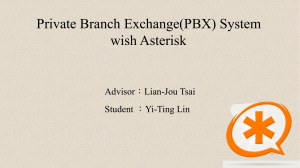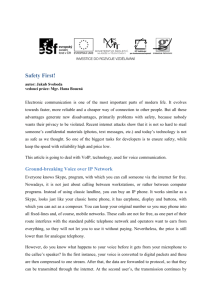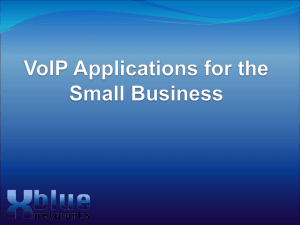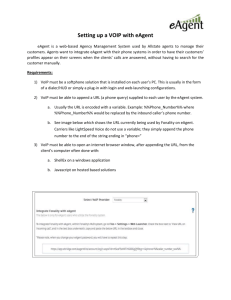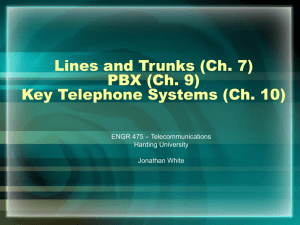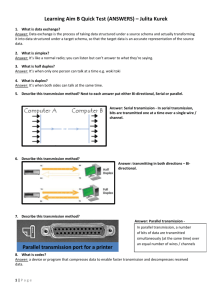Bandwidth Costs - (ISOC) Workshop Resource Centre
advertisement
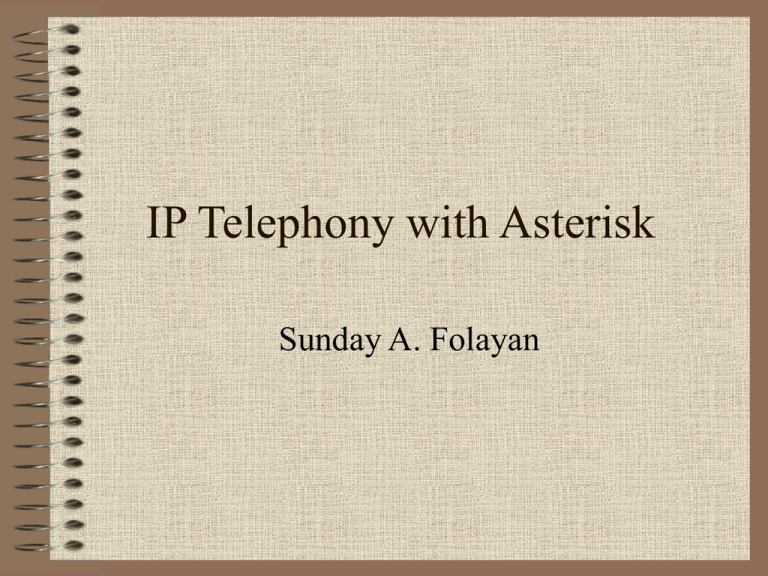
IP Telephony with Asterisk Sunday A. Folayan Disclaimer I am NOT an expert in VoIP technology I am NOT PRETENDING to be one. I am a user who just got interested in the technology. … and its coolness What I say may not be what it is, but how I understand it. Do not believe what I say wholesome, but seek your own understanding If you know that what I just said is a lie, please be kind to challenge me! IP Telephony 101 Once upon a time, this was a means of Transportation … a 4x4 gas-efficient All Terrain! There lived the PSTN …. • A few years ago, everyone struggled to convert data (IP) into sound, and move it over the Public Switched Telephone Network (PSTN) infrastructure [using MODEMs] Enter VoIP …. The packetisation and transport of classic public switched telephone system audio over an IP network. The analog audio stream is encoding in a digital format, with possible compression and filtering, before encapsulating it in IP for transport over LAN/WAN or the public internet Infrastructure Convergence or Extinction? • Now … everyone is struggling to convert PSTN sound into data, and move it over well established IP links. [using CODECs] Technology has just reversed the process Voice Technology Matrix FXS/FXO POTS FXS/FXO Cisco ATA Channel Bank Voice PRI ISP1 PSTN1 ?? ISP2 IP IP Phone TDM PSTN2 RAD TDMoIP VoIP provides a choice of Providers and paths Roaming Mobile Telco Mobile operator .ke Fixed Line e164.arpa PSTN dns ENUM tree ENUM lookup +27 217 451230 Query NAPTR 200067@fwd.pulver.com Randy@psg.com PRI: +43 1 79564 Invite:100@84.201.255.254 AS5300 19343@fwd.pulver.com Freeworld Dialup Psg.com Psg.com DB based subscribers 19918@fwd.pulver.com TESPOK SIP Proxy HP Ze5500 asterisk Server Call forwarding to AS 5300 Sghuter@nsrc.org Why TDM does not scale • PSTNs traditionally (Graham Bell Era) stuff a single call on a single cable pair … and charge for 1 pair! • PSTNs then stuffed multiple calls on a single cable pair using Time Division Multiplexing (TDM) and charge as multiple pairs!! – • • • • • BRI, PRI, ISDN, E1 T1 etc are all TDM technologies with diverse switching and Timing technologies PSTNs are now stuffing almost all calls into IP and they still keep the entire honey pot TDM is wasteful. Cannot utilize time slots carrying a period of silence in conversations VOIP is incompatible with the PSTN’s charging model! TDM introduces complex settlement systems, rendered obsolete by IP TDM just does not scale! IP vs VoIP VoIP introduces a collection of protocols and devices that allow for the encoding, transport and routing of audio calls over IP networks. Voice IP Voice [P2P, Skype, Messanger] Voice IP PSTN [Net2Phone, Deltathree] Voice [PSTN] IP PSTN [iBasis, ITXC] Voice [GSM] IP GSM/PSTN [???] Games the big boys play … PSTN1 ISP1 IP ISP2 TDM PSTN2 Little kids also play … ISP1 Intern.l PSTN IP Phone IP ISP2 IP Phone TDM National PSTN The VoIP edge • • • • IP is Scaleable IP conserves capacity IP simplifies charging and billing A turf for ISPs to play on … – Softphones for Pc to Phone and PC to PC calls – Web-based applications for web to phone services – Move phones into the IT department and away from the expensive PBX consulting firm – Interconnecting office PBXs at zero network cost – Give ubiquitous access to the PBX for home/traveling employees – PBX features such as Voicemail, Call blocking, Call forwarding, Call Conferencing, Follow me etc as added services Universal Access Intern.l PSTN ISP1 IP Phone IP ISP2 IP Phone National PSTN VoIP Building block VoIP is not built on TCP, but RTP • • RTP (Real-Time Transport Protocol) RTCP (Real-Time Control Protocol) – – – RTP is a UDP stream with no intelligence for QOS or resource reservation Contains a packet number for detection of packet loss and re-sequencing of out of order packets. Unidirectional : two streams in any call VoIP Building block • • • • • Calls are CODed to IP or DECoded from IP. CODECS vary in sample size, usually Kbits per second Decoding can include echo cancellation Decoding can compensate for jitter IP routers do not need to decode voice passing through them VoIP Building block Sample CODEC Sizes – – – – – – – – G711alaw G711ulaw ILBC Speex Gsm G729 G723 Iax2 (trunked) 64k 64k 15k 2.15 – 44.2k 13k 8k 5.3 - 6.3k 4k Codecs that compress to lower bandwidth are CPU intensive, unless the codec is implemented in hardware. Strike a balance! Control Protocols • H323 – Complex, multiple flow, ancient – Has a large install base • Session Initiation Protocol (SIP) – New, simple, only sets up RTP streams • Cisco Skinny (Proprietary) – Allows complete phone customization • MGCP (media Gateway Control Protocol) – Good but Not widely deployed as SIP • IAX (Inter-Asterisk eXchange) – Simple, transverses NAT, Compressed SIP • SIP messages are HTTP-like and readable • Supports Video • There's lots of hardware SIP units available – Grandstream BT-101/2 – Cisco 79xx ) • Not suited for Trunking (pbx to pbx) • SIP is responsible for the increased use of VoIP IAX(2) • • • • • • • Inter Asterisk Exchange Not many Hardware phones support IAX. Soft Clients available for *unix/Windows Works behind NAT Has Trunking support built in Very low bandwidth requirement Built for asterisk Phones • Soft phones – X-lite - www.xten.com (Windows) – Lipz - www.lipz4.com (Linux) – DIAX - http://www.laser.com/dante/diax/diax.html (Windows) – PhoneGaim www.phonegaim.com(Linux) – Linphone - www.linphone.org (FreeBSD) – Sjphone - http://www.sjlabs.com/sjp.html (Windows, WinCE, Mac) – Lots of others Phones • Hard phones – – – – – Cisco 79XX’s Grandstream BT 10X’s Snom 100/200’s LOTS of h.323 phones from .tw ;-) Many other phones Most IP phones can work Peer to Peer It is the Ability to use a PC as switch or PBX that really makes VoIP rock!! Simply loading a software PBX on a PC offers new possibilities … PBX Software Call Manager – – – – – – Closed Source 13 16 CD’s Web Interface Requires CCNA to setup Needs extremely powerful Server Leaves PRI/FXO/FXS to other devices Asterisk – – – – Open Source A large array of tools and add-ons Uses industry-wide devices and equipment Can be setup in one night What is in VoIP for operators? Some uncharted colonies … • • • • • WiFi/WiMax Phones for universal access True Global roaming ;-) Enum adoption Numbering plan, being able to really “Play” Receivership for Long Distance companies Asterisk Open-Source IP PBX Asterisk is not … • • • • • • A billing system A CRM system A web server or XML server (re: Cisco 79xx) A configuration tool for VoIP devices A voice recognition system A USENET or email client Asterisk is a …. • • • • • • Telephony gateway (TDM - PRI,POTS) VoIP Gateway (IP channels) IVR system (Interactive Voice Response) Voicemail system Meet-me Conference system Scriptable telephony-to-anything (Perl, C, etc.) • Automatic Call distribution (ACD) system Practical Uses (office) • • • • Ditch your LD company Interconnect office PBXs at zero network cost Get “Unified Messaging” Give ubiquitous access to the PBX for home/traveling employees • Disaster recovery scenarios • Move phones into your IT department and away from your expensive PBX consulting firm • Eliminate adds/moves/changes as physical chores System Requirements • No clear rule of thumb on processor size; at least 400mhz PIII recommended • Works on almost all Linux Distributions and FreeBSD • Source + binaries (including sounds) are ~35Mb • Using complex codecs (i.e.: G.729, speex, etc.) will increase processor load dramatically Estimated CPU Sizing Purpose Simultaneous calls Minimum Recommendation Hobby System <5 SoHo System 5 - 10 X86 1Ghz 512Mb SMB System 10 - 15 X86 3Ghz 1GB Large >15 X86 400Mhz 256MB Dual CPU, Clusters Compatible Interfaces Many interfaces for converting between Voice/IP/TDM are compatible with Asterisk. These include – – – – – – POTS cards (Digium, Zapata, Voicetronix, etc.) TDM Digital (AdTran VoFR, Digium E1/T1, etc.) CAPI (ISDN card support for Linux ISDN driver) USB dongle for FXS Modem drivers for certain modems Speaker/headphones via soundcard Basic Installation Steps 1. 2. 3. 4. 5. Setup CPU and operating System Install desired hardware based on application intended Download asterisk from www.asteriskpbx.org Compile and install with “Make” Load Appropriate drivers [None is needed for IP or soft phone] 1. 2. 3. 6. 7. Configure modules.conf Configure either sip.conf or iax.conf Configure extensions.conf Start Asterisk Make calls! Extensions.conf (Call Flow) • Calls come in on channels and are then handed to the “extensions.conf” file, which is the dialplan • Dialplan contains logical sections of matches called ‘Contexts,’ and each channel sends a call into the dialplan with a context name and a dialed number • The dialplan then matches (with modified regexp’s) the number being dialed, and runs applications accordingly • Each match on the dialed number has an order of steps called ‘Priorities’, and are indicated with an integral incrementing number (BASIC-like) Other use …. • Call queues - you can build a call center with Asterisk, with various call weightings and agent logins/hot seating • Multi-ring, cascading ring with different technologies (inbound calls forward to your desk line and your cell phone - first answer gets it) • Multi-language support with same dialplan • Festival integration for voice synthesis References …. • • • • • • • • • • • • • http://www.asterisk.org/ http://www.digium.com/ http://www.voip-info.org http://www.loligo.com/asterisk/ http://www.wwworks-inc.com/asterisk/ http://www.xten.com/ http://resources.nznog.org/Wednesday-220306/JonnyMartinAsteriskPBX/NZNOG06-Asterisk_JM.pdf http://www.onlamp.com/pub/a/onlamp/2003/07/03/asterisk.html http://www.nznog.org/crigby-voip-intro.ppt http://www.loligo.com/asterisk/misc/presentations/asterisk-overview.v1.0.ppt http://docbox.etsi.org/tispan/open/enum-workshop-20040224sophia/08.%20r%20stastny%20austria_v4.ppt http://www.ietf.org/proceedings/03jul/slides/enum-3/enum-3.ppt http://www.ispa.at/downloads/c8431676f72b_200305_ispa_enum_voip_stastny.ppt
